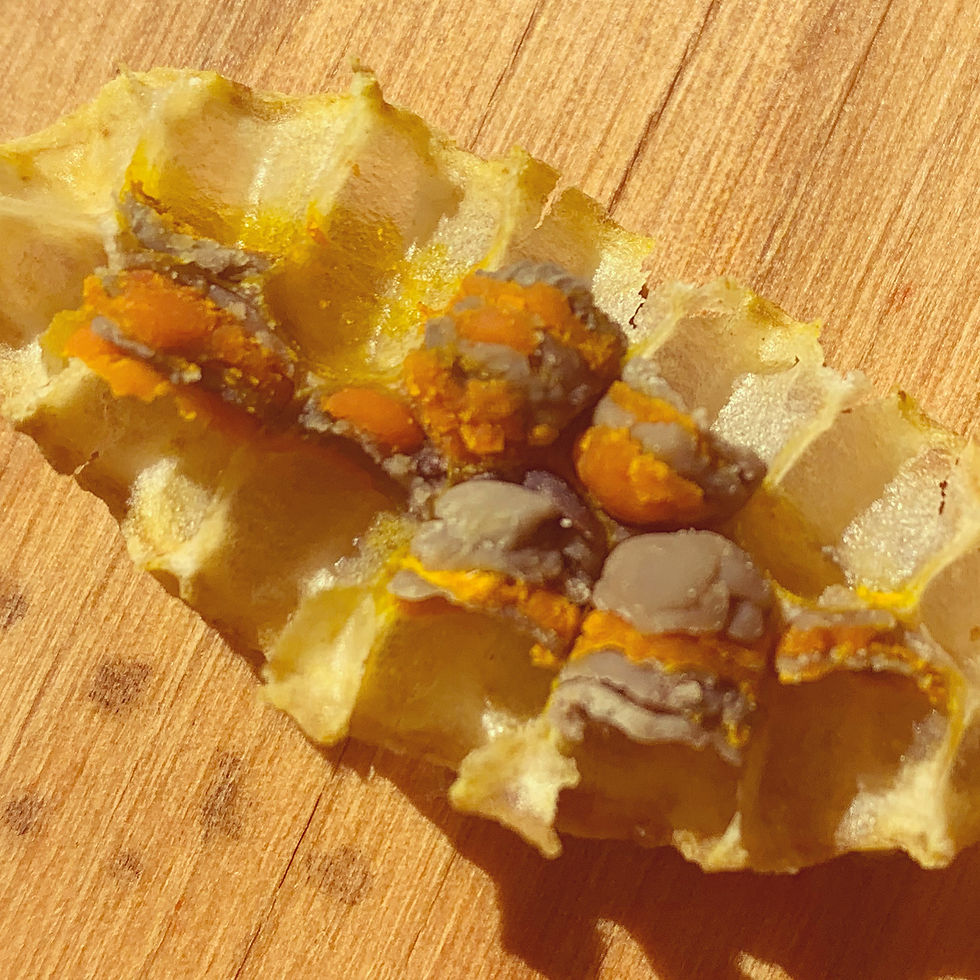Newbees: What Is That? (Part 1)
- rushingriverapiaries
- Jun 27, 2022
- 3 min read
Updated: Apr 30, 2024
This is a photo tour of things that you can expect to see in your hive so that you know what you're looking at. In this post (Part 1), these are all the things that you WANT to see.
On each hive inspection, I like to see 4 things:
Evidence of the queen
All stages of brood
Food stores
Absence of disease
Evidence of the Queen
The queen is not much wider than a worker bee, but is considerably longer. If you see "a big bee," is it likely a drone. If you see "a long bee" then that's your queen!
Often, the queen has different colouration than the rest of the bees. It's worth making a note of what your queen looks like so that you know what to look for on your inspections.
Spot the queens in each of the images below:
If you don't see your queen during an inspection, it's OK as long as you see eggs or very small larvae. This means that she was present during the past 3-4 days and is likely still there unless the hive has been disrupted somehow.
Learning to spot bee eggs is a critical beekeeping skill (even more important the queenspotting!). Here are my best tips for finding eggs:
Use black foundation
Look for big juicy white larvae first, then find the gradient (as they get smaller). Follow the gradient until it becomes eggs.
Look in areas surrounded by capped brood
Hold the frame at eye level and turn so that the sun is shining over your shoulder and right down into the cells.
Wear reading glasses. If you need them for reading, then you'll need them for egg-spotting.
Blow gently on the bees to make them move out of the area you are looking at.
This photo makes them look so obvious, but it can be REALLY tricky to spot eggs on older frames with bees crawling all over them!

All Stages of Brood
Worker bees have a fairly short life expectancy - not much more than a month in the summertime. For this reason, it is important that there are always new bees being raised in the hive so that the population continues to grow throughout the season. Seeing all the stages of brood lets you know that new generations of bees are on the way.
The three stages of brood you want to see on every inspection are (1) eggs, (2) larvae, and (3) capped brood.

Food Stores
Bees need both honey and pollen. Honey is primarily the food of adult bees, while pollen is fed to larvae (it's more complex than this but that's for another day). You want to make sure that there is some of each in your hive at all times. If there is not, then you need to supplement feed to help your hive thrive.
Honey looks like water when it first comes into the hive. If it looks wet, it's honey (well, probably nectar, but on its way to becoming honey). Once it is ready, the bees cap it (see the white in the first photo and the golden caps in the third photo).
Pollen is more colourful and opaque. It can also look shiny or wet (some honey is added to turn it into "bee bread"), but it always has colour. The colour can range from yellows, oranges, and reds, to greens and blues!
Absence of Disease
We're going to save these photos for another post. Suffice to say for now that as long as nothing looks "gross" or smells funky, you're probably free of the more acute bee ailments.
Other Perfectly Normal Stuff to See
Propolis is bee glue and medicine. It can be red, greenish, or golden.
This is pollen packed in a cell that has been torn open.

This is drone brood (larvae) that have been torn open because it was built between boxes.

Bumpy brood is drone brood. Some is healthy and expected. If you have more lumpy brood than flat, it can signal a problem with your queen.

Small queen cups (sometimes called tea cups) are perfectly normal and do not mean anything until there is a larva and royal jelly inside. Then it becomes a queen cell. If you're seeing a loaded queen cell, read this.

Looking for more?
Looking for more beekeeping education? You can find my virtual, on-demand beginner and intermediate courses at https://courses.rushingriverapiaries.com
Or if you'd prefer a more tailored experience, you can join my mentorship group at https://www.patreon.com/thehivementorship





























Comments